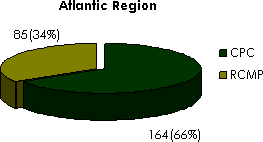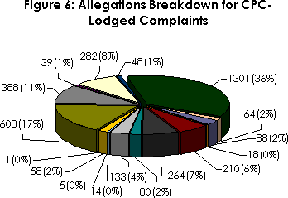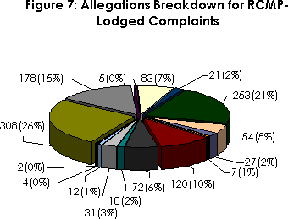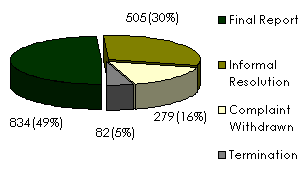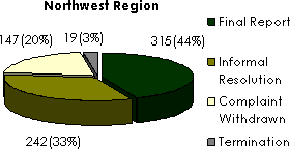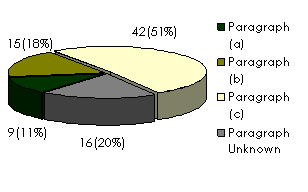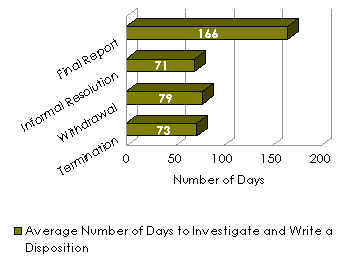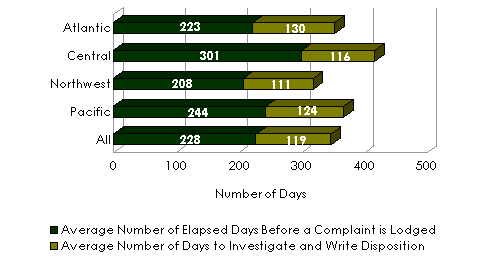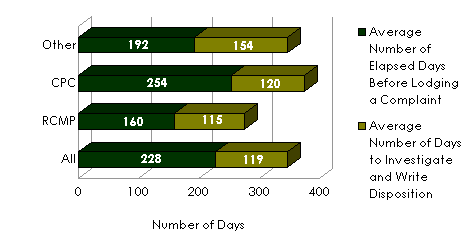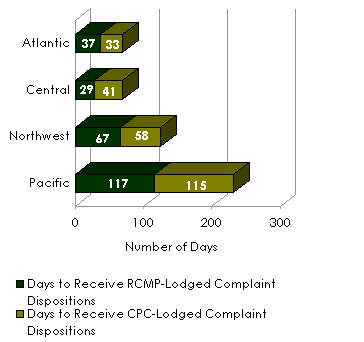Review of the Record Project – 2009
Table of Contents
- Recommendations
- Executive Summary
- Common Terminology
- RCMP-Wide and Regional Analysis
- Received Complaints
- Disposition of Complaints
- Chronic and Multiple complaint Complainants
- Service Standards: Processing Times
- Appendices
- Issues List
- Public Complaint Process
- Complaints by Member Rank
- Complaint Allegation Categories
- Force-Wide Issues Breakdown
- Force-Wide Allegations Breakdown
- Allegations Breakdown by region
- Allegations Breakdown Based on the Organization the Complaints Were Lodged With
- Allegations Breakdown for Final Reports
- Supported and Unsupported Allegations
- Allegations Breakdown for Informal Resolutions
- Allegations Breakdown for Withdrawn Complaints
- Allegations Breakdown for Terminated Complaints
Recommendations
Based on the results of the Review of the RCMP's Public Complaint Records 2009 Project, and also recognizing the importance of further strengthening the public complaint process, the Commission recommends to the RCMP the following:
Recommendation No. 1
That the RCMP clarify its policies and procedures regarding the different types of public complaint dispositions, particularly regarding the acceptance of informal resolutions dealing with serious allegations.
Recommendation No. 2
That the RCMP work to further standardize its public complaints policies and procedures among its divisions by continuing to develop a national policy and handbook and providing training.
Recommendation No. 3
To enhance consistency and adherence to policy, that the RCMP consider revising the delegation of the Commissioner's authority with respect to the issuance of Notices of Direction for terminations from the detachment level to, at least, the level of officer (or non-commissioned officer) in charge of the divisional professional standards units.
Executive Summary
The Commission for Public Complaints Against the RCMP (Commission) is an independent body established in 1988 to receive and review complaints about the conduct of regular and civilian RCMP members in the performance of their policing duties. Its findings and recommendations help identify, correct and prevent the recurrence of policing problems caused by the conduct of specific RCMP members or by flaws in RCMP policies or practices.
In accordance with paragraph 45.47(b) of the Royal Canadian Mounted Police Act (RCMP Act), the Commission established the Review of the RCMP's Public Complaint Records Project in 2007 with the primary objective of examining, on an annual basis, all complaint dispositions stemming from public complaints against the RCMP. The project is comprised of two main components: a) the Review of the Record, which assesses all completed complaint dispositions; and b) the Outstanding Disposition List, which tracks all open complaint files.
The project aims to:
- confirm that the RCMP's statutory mandate and responsibilities related to public complaints provided for in Part VII of the RCMP Act are being met;
- identify and analyze complaint issues and trends that might form the subject of further examination or action;
- provide both the Commission and the RCMP with an evidentiary basis upon which to identify systemic issues within the public complaints process; and
- encourage collaboration with the RCMP to identify opportunities for change and improvement.
The data collected for this report is from calendar year 2009 and is based on all completed public complaint dispositions received by the Commission before August 13, 2010Footnote 1, with a recorded complaint date between January 1, 2009 and December 31, 2009.
Overall, the Commission received 1,700 completed public complaint dispositions from the RCMP relating to complaints lodged within the 2009 timeframe. While this represents a 7% decrease relative to the 1,829 complaint dispositions reported in 2008, it still remains 18% higher than the 1,440 reported in 2007.
It should be noted, however, that the Commission has been notified by the RCMP that 2,367Footnote 2 complaints were lodged in 2009. As a result, approximately 28% of complaints remained outstanding at the time this report was written.
Of the 1,700 complaint dispositions in 2009, 1,216 (72%) were lodged with the Commission while 471 (28%) were lodged with the RCMP. An additional 13 complaints were lodged initially with other organizations,Footnote 3 representing 1% of the total complaints. With respect to the number of Commission-lodged and RCMP-lodged complaints for 2009, this represents a 3% increase and a 4% decrease, respectively, from 2008 key findings.
In 2009, the RCMP's Northwest RegionFootnote 4 received the highest number of public complaints (723), representing 42% of the total, while the Central RegionFootnote 5 received the lowest with only 4% (72). In terms of the two remaining regions, the Pacific RegionFootnote 6 received 39% (656) of public complaints while the Atlantic RegionFootnote 7 received 15% (249).
A total of 4,835 allegations were made against the RCMP and its members in 2009, which represents a 7% increase over the previous year.
The three most common complaint allegations as identified by the RCMP were "Neglect of Duty" (32%), "Improper Attitude" (19%) and "Improper Use of Force" (12%).
Once received by the RCMP, there are four ways in which a public complaint can be resolved. In 2009, the RCMP issued a Final Report in 49% of all cases, arrived at an informal resolution in 30% of the cases, issued a Notice of Direction (termination) in 5% of the cases, and accepted a withdrawal in 16% of the public complaints. The Commission remains concerned that the RCMP has, in some cases, continued to informally resolve more serious allegations (e.g. "Improper Use of Force").
In 2009, the RCMP took, on average, 119 days to issue a disposition once a complaint was lodged. This represents a 16-day increase in processing time when compared to the 103 days reported in 2008. Of particular interest is the fact that, on average, 228 days elapsed before a complainant lodged a complaint after an incident of concern, a 28-day increase over the average of 200 elapsed days in 2008.
Through the Review of the RCMP's Public Complaint Records Project and other initiatives, the Commission will continue to work closely with the RCMP to identify trends and issues that can be utilized to improve the quality of, and enhance public confidence in, the overall public complaints system.
Map of RCMP Divisions
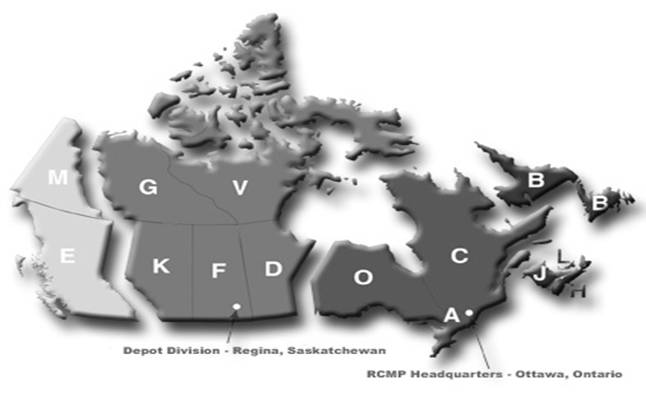
The divisions are as follows:
"A" Division: National Capital Region
"B" Division: Newfoundland and Labrador
"C" Division: Quebec
"D" Division: Manitoba
"E" Division: British Columbia
"F" Division: Saskatchewan
"G" Division: Northwest Territories
"H" Division: Nova Scotia
"J" Division: New Brunswick
"K" Division: Alberta
"L" Division: Prince Edward Island
"M" Division: Yukon
"O" Division: Ontario
"V" Division: Nunavut
Common Terminology
Allegation: Assertion of misconduct in the performance of any duty or function, by a member of the public, against any member or person employed or appointed under the RCMP Act.
Chair Initiated Complaint: A Chair-initiated complaint can be made under Part VII of the RCMP Act. The Chair may initiate a complaint if he is satisfied that there are reasonable grounds to do so. This can occur when the Chair becomes aware of the conduct of any RCMP member and, based on the information available, considers there are reasonable grounds to investigate that conduct.
Commission's Issues List: Consists of 46 categories, which describe the nature of the public complaint. The process of assigning issues raised in complaints is completed when the Commission receives completed complaint records through the Review of the RCMP's Public Complaint Records project. For a complete listing of all issues with corresponding definitions, see Appendix A.
Complaint Disposition:r RCMP-initiated settlement of a public complaint against a member
Completed Complaint Record: All RCMP paperwork relating to a public complaint and the disposition of a complaint, if necessary.
Final Report (RCMP): One of the four types of complaint dispositions issued by the RCMP to the complainant(s) provided for under subsection 45.36(5) of the RCMP Act stating the RCMP's findings relating to its investigation into the public complaint.
Notice of Direction: One of four types of complaint dispositions issued by the RCMP, under subsection 45.36(5) of the RCMP Act, to the complainant(s) stating the RCMP's decision not to investigate the complaint or to terminate the investigation into the complaint.
Outstanding Disposition List: Accounting mechanism for all Commission-lodged public complaints currently under investigation by the RCMP. It allows the Commission to track how quickly the RCMP is responding to complaints, and in particular, identify complaints that are taking too long to investigate.
Public Complaint Process: A series of procedures undertaken by the RCMP and the Commission to address a public complaint against a member of the RCMP. This can include, but is not limited to, complaint intake, investigation by the RCMP, issuing of complaint dispositions and complaint reviews. For a flow-chart of the public complaint process, see Appendix B.
Public Interest Investigation: Regardless of whether or not a complaint has been investigated, reported on, or otherwise dealt with by the RCMP, the Chair may investigate or institute a public hearing into a complaint concerning the conduct of a member where he or she deems it in the public interest.
RCMP Allegations Category: Part of the RCMP classification system of complaints found on Form 4110, where each allegation made by a member of the public is assigned a specific mutually exclusive classification reflecting the nature of the allegation.
RCMP Region: A geographical term describing an area of provinces or territories where RCMP has jurisdiction or is present. Regions are subdivided into divisions.
Statutory Mandate: Legal authority provided for by legislation.
Statutory Requirement: Legal obligation as provided for by legislation.
RCMP-Wide and Regional Analysis
Since the Commission is unable to produce a real-time account of how many complaint dispositions the RCMP has issued at any given moment, or how many complaints have been lodged in total, the Commission must rely on the RCMP to provide complaint dispositions in a timely mannerFootnote 8 in order for the Commission's Review of the Records database to be as complete as possible. Given the nature of the public complaint system and the time involved in investigations, the Commission will likely continue to receive complaint dispositions for complaints lodged in 2009 well into 2010 and 2011. As a result, this report analyzes only those public complaints lodged in 2009 for which the RCMP has completed a complaint dispositionFootnote 9 prior to the present report's production.
Furthermore, due to the limited number of complaint dispositions submitted by some divisions and concerns regarding the handling of certain cases, the ability of the Commission to draw conclusions or provide more fulsome analyses is somewhat limited.
Finally, in recognition of the significant human resource impacts that the Vancouver Winter Olympics and the G8/G20 Summits had on the RCMP and its professional standards units in 2010, the Commission agreed to extend the final submission date for completed complaint dispositions by approximately six weeks. While this decision has allowed for the analysis of a larger dataset for the 2009 year, the Commission recognizes that the delay may complicate direct year to year reporting.
As such, based on the aforementioned limitations, caution must be applied when examining the Review of the RCMP's Public Complaint Records report as total completed complaint dispositions does not accurately represent all public complaints lodged against the RCMP in 2009, only those complaints for which a completed Form 4110 and a disposition have been issued.
Nevertheless, the Commission has attempted to identify strengths, areas of improvement and areas of concern regarding the RCMP public complaint process, including member conduct, complaint resolutions and administrative issues which, the Commission feels, should be given further consideration by the RCMP as a whole.
Received Complaints
The data collected for 2009 was based on all completed complaint records received before August 13, 2010,Footnote 10 with complaint dates between January 1, 2009 and December 31, 2009.Footnote 11 The Commission received 1,700 completed complaint dispositions related to complaints lodged within the 2009 timeframe; a 7% decrease from the total number of completed complaint dispositions reported in the 2008 Review of the RCMP's Public Complaint Records report.
Nevertheless, the Commission was notified by the RCMP that a total of 2,367 complaintsFootnote 12 were lodged in 2009. As such, approximately 28% of complaints remained outstanding at the time this report was written.
The Northwest RegionFootnote 13 received the highest number of completed complaint dispositions (723) representing 42% of the total, while the Pacific RegionFootnote 14 received 656 (39%); the Atlantic RegionFootnote 15 received 249 (15%); and the Central RegionFootnote 16 received 72 (4%). Although the number of completed complaint dispositions received by the Commission at the time of writing this report was lower than the previous year, the distribution throughout the Atlantic and Central Regions remained relatively constant from 2008. In contrast, 2009 experienced a 4% increase in the proportion of completed complaints received in the Northwest Region, while the share of completed complaints received in the Pacific Region, which was highest in 2008, decreased by 6% compared to the previous year.
Figure 1: Total Number of Complaints by RegionFootnote 17
Of the 1,700 completed complaint dispositions, 1,216 were lodged with the Commission (72%) while 471 were lodged with the RCMP (28%). The remaining 13 recorded complaints (1%) were lodged with other bodiesFootnote 18. Consistent with previous years' findings, the proportion of Commission-lodged complaints increased by 3% from 2008, while the proportion of RCMP-lodged complaints decreased by 4% from the previous year. This shift may be reflective of the general trend toward greater awareness of review bodies across Canada and an increased comfort level in filing complaints with the Commission.Footnote 19
Figure 2: Number of Complaints Lodged with the Commission versus the RCMP

Regional breakdown
From a regional perspective, complainants in the Northwest Region lodged 70% of complaints with the Commission, 28% with the RCMP, and 2% with other organizations. In 2008, 60% of complaints were lodged with the Commission, 39% were lodged with the RCMP and 1% was lodged with the FSIN and the Alberta Solicitor General combinedFootnote 20. This 10% increase in the proportion of Commission-lodged complaints is representative of the aforementioned growth in Commission-lodged complaints at the national level. Likewise, the comparative decrease in RCMP-lodged complaints is consistent with the overall decline in RCMP-lodged complaints at the Force-wide level.
In the Pacific Region, where the Commission maintains a national complaint intake office located in Surrey, BC, 75% of complaints were lodged with the Commission, while complaints lodged with the RCMP accounted for only 25%. Although there is a 2% decrease in the proportion of Commission-lodged complaints compared to 2008, it is clear that complainants continue to favor reporting complaints with the Commission compared to the RCMP.
In the Atlantic Region, 66% of complaints were lodged with the Commission, while 34% of the total was lodged with the RCMP. This ratio can be attributed to the heavy reliance on the RCMP when lodging complaints in "H" Division, where 49% of complaints were lodged with the RCMP and 51% with the Commission.
In the Central Region, 71% of total complaints were lodged with the Commission, while 29% of complaints were lodged with the RCMP.
Figure 3: Regional Breakdown in Number of Complaints Lodged with the Commission versus the RCMP

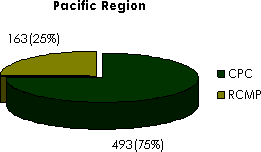
In addition to receiving complaints about specific members, the Commission has, on occasion, received complaints against entire RCMP detachments. In 2009, the Commission received 45 complaints of this nature, representing 3% of the overall completed complaint dispositions for the year. In contrast to 2008, the total number of complaints against whole detachments declined by over 50%.
The Pacific Region, specifically "E" Division, incurred the highest number of complaints against entire detachments: 19 complaints corresponding to 2.9% of the region's total completed complaint dispositions. Comparatively, the Central Region, while receiving only 3 complaints of this nature, experienced the highest percentage per total, with 4.2% of its overall completed complaints representing complaints against entire detachments.
A further 5 separate complaints were lodged against the RCMP organization as a whole.Footnote 21
Figure 4: Number of Complaints by Member Rank
The Commission also tracked data relating to the characteristics of those members subject to a complaint with the purpose of, for example, identifying any potential indicators of complaint behaviour. In 2009, the average number of members implicated in a complaint was 1.6; meaning, between 1 and 2 members were generally identified when a complaint was lodged.
Given that most front-line policing within the RCMP is performed by constables and corporals, it is not surprising that 73% of members subject to a complaint were identified as constables. Corporals represented 12% of member ranks identified in complaint cases and sergeants represented 7% of identified members subject to a complaint. Comparatively, there is little statistical difference between the figures presented from 2007 to 2009.
For a complete list of complaints by member rank, as illustrated above, see Appendix C.
In the coming years, the Commission will work with the RCMP to gather further demographic information in order to establish a more complete picture of those members subject to complaints.
Allegations
A total of 4,835 allegations, an increase from 4,511 reported in 2008, were made against the RCMP and its members, representing an average of approximately 2.8 allegations per complaintFootnote 22. It is interesting to note that, while the total number of completed complaint dispositions tracked in 2009 is below that of 2008, allegations per complaint exceeded that of the previous year, which averaged approximately 2.5 allegations per complaint.
The most common complaint allegations identified were "Neglect of Duty" (32%), "Improper Attitude" (19%) and "Improper Use of Force" (12%). Of note, serious allegations, including "Improper Use of Force", "Improper Use of a Firearm" and "Statutory Offence" accounted for 15% of total allegations, which is consistent with the previous year's proportion of 14%.
For a complete breakdown of the Force-wide allegations illustrated below, see Appendix F.
Figure 5: Force-Wide Allegations Breakdown
Regional breakdown
From a regional perspective, the most common complaint allegations identified by the RCMP in the Northwest Region were "Neglect of Duty" (35%) and "Improper Attitude" (19%), as well as "Irregularity in Procedure" and "Improper Use of Force" at 9% each. Again, these results are consistent with the findings reported in 2008. Of note, while the region experienced a 2% decline in its proportion of "Statutory Offence" allegations, it continued to maintain
the highest Force-wide average in this allegation category, accounting for 75% of the national total.
Likewise, in the Pacific Region, the three most common complaint allegations were "Neglect of Duty" (29%), "Improper Attitude" (17%) and "Improper Use of Force" (16%). In fact, the Pacific Region sustained the highest Force-wide average of "Improper Use of Force" allegations, incurring 54% of the national total in this category.
In the Atlantic Region, the most common allegations were "Neglect of Duty" (29%), "Improper Attitude" (26%), and "Improper Use of Force" (11%), which surpassed "Irregularity in Procedure" and "Oppressive Conduct", each declining from 12% of regional complaint allegations as reported in 2008 to 6% and 7%, respectively, in 2009. It is of note that "L" Division and "H" Division were among the divisions with the highest proportions of reported "Improper Attitude" allegations, with 49% and 30%, respectively.
The Central Region experienced the greatest shift in allegations relative to 2008, with the three most common representing "Neglect of Duty" (48%), which increased by 23% from the proportion reported in the previous year, "Oppressive Conduct" (17%) and "Improper Attitude" (16%). The latter two allegations declined from 22% and 24%, respectively, as reported in 2008.
For a complete breakdown of allegations by region, see Appendix G.
Over the three-year Review of the RCMP's Public Complaint Records Project, the Commission has continued to track allegations lodged with the Commission versus those lodged with the RCMP. This data collection is performed for the purpose of identifying whether certain allegation types are more likely to be lodged with the Commission, due to the seriousness of the complaint or the complainants' level of comfort in dealing with an independent agency.
In 2009, with the exception of "Other" allegations (33%), all allegation types were more likely to be lodged with the Commission. The current reporting year also experienced an increase in "Statutory Offence" allegations lodged with the Commission (54%), which were more likely to be reported to the RCMP (51%) in 2008.
In fact, 9 of the 17 allegation types were lodged with the Commission at least 75% of the time. These allegation types included: "Improper Use of Firearms" (89%); "Irregularity in Procedure" (76%); "Neglect of Duty" (83%); "Mishandling of Property" (77%); "Improper Arrest" (79%); "Improper Persons/Vehicles Search" (82%); "Improper Search of Premises" (79%); "Equipment" (100%); and "Service" (92%).
These figures are indicative of the overall trend toward increased Commission-lodged complaints, relative to the RCMP, and a growing awareness and understanding of the Commission in the RCMP public complaint process across Canada.
Issues
Finally, for every complaint disposition received, the Commission analyzed the incident details in order to identify issues related to the nature of the complaint.Footnote 23 The most common issues associated with the complaints in a Force-wide analysis were "Attitude"Footnote 24 (16%), "Criminal Investigation Quality (RCMP)" (9%), "Arrest" (8%), "Vehicular Incidents" (8%) and issues related to "Service" (7%), which declined from 12% as reported in the previous year. Of note, "Police Physical Abuse (no restraints)", which often corresponds to "Improper Use of Force" allegations, accounted for 5% of complaint issues reported throughout the year.
Overall, a total of 5,708 issues were reported in 2009, a slight increase from the 5,623 issues tracked in the previous reporting year. A comparison of these figures reveals a general consistency across the majority of complaint issues identified, albeit with a few exceptions. While representing a small percentage of total issues, complaint dispositions involving lethal weapons have steadily
increased, from 19 reported issues in 2007 to 45 in 2009. In regard to issues dealing with chemical irritants, specifically pepper spray, 2009 experienced a growth in cases, from 21 complaint issues in 2008 to 33 complaint issues in the current reporting year. In contrast, complaint dispositions related to conducted energy weapons (CEWs) declined from 35 issues reported in 2008 to 25 in 2009. Attention was also given to the number of complaint dispositions involving police dogs, including cases of dog bites, which decreased from 23 issues to 16 issues over the past two reporting periods. Finally, complaints dealing with mental illness jumped from 69 reported issues in 2008 to 90 issues in 2009. For a complete breakdown of Force-wide issues, see Appendix E.
Regional breakdown
Broken down by region, the three most common issues raised in the Northwest Region were "Attitude" (14%), "Criminal Investigation Quality (RCMP)" (10%), and "Arrest" (9%).
Likewise, in the Pacific Region, the most common issues included "Attitude" (15%), "Arrest" (9%), and "Vehicular Incidents" (9%). Of note, policy issues declined from 19 or 0.9% of total issues in 2008 to a mere 2 cases, accounting for less than 0.1%, in 2009.
Complaints in the Atlantic Region often included issues related to "Attitude" (18%), "Vehicular Incidents" (10%), and "Criminal Investigation Quality (RCMP)" (10%), an issue that doubled in reported cases relative to 2008.
Finally, the three most common issues raised in the Central Region were "Attitude" (18%), "Service" (15%), and "Criminal Investigation Quality (RCMP)" (13%).
Disposition of Complaints
Once the RCMP has received a complaint, there are four ways that a complaint can be resolved:
- A complaint can be investigated by the RCMP and a Final Report issued;Footnote 25
- A complainant and the member(s) involved can agree to an informal resolution;
- A complainant can request to freely and voluntarily withdraw his or her complaint;
- A complaint investigation can be terminated under limited provisions identified in the RCMP Act.
In its handling of complaints, the RCMP issued a Final Report in 49% of the cases, entered into an informal resolution in 30% of all cases, issued a Notice of Direction (termination) in 5% of cases, and accepted a complaint withdrawal in 16% of the cases. These figures are consistent with the percentages reported in the previous year.
Figure 8: Number of Complaints by Disposition Type
While certain complaint allegations are repeatedly dealt with using one of the four specific disposition types,Footnote 26 there can be some variation across regions and divisions in terms of how complaints are handled. For example, the proportion of informal resolutions varied from 13% of total dispositions in the Central Region to 33% in the Northwest Region. This variation may reflect the tendency of complainants in certain geographical areas to agree to informal resolutions with members instead of awaiting the results of a formal investigation. Furthermore, terminations accounted for 22% of complaint dispositions in the Central Region, while only 2% in the Atlantic Region; a region which relied heavily on formal investigations and Final Reports in 2009.
Figure 9: Regional Breakdown in Number of Complaints by Disposition Type
As illustrated, while all regions were prone to issuing Final Reports, a comparison reveals that the Northwest Region experienced the highest proportion of informal resolutions, a large share of which originated in "G" Division, along with the highest proportion of withdrawals, which is reflective of the large percentage reported in "V" Division. The Atlantic Region recorded the highest percentage of Final Reports and the Central Region experienced the largest proportion of terminations, which can mostly be attributed to "O" Division.
Investigations and Final Reports
Of the complaint dispositions received by the Commission, 834 were formally investigated and a Final Report issued, representing 49% of the total Force-wide dispositions. These reports involved 3,032 allegations, with "Improper Use of Force", "Statutory Offence", "Improper Arrest" and "Mishandling of Property" most likely to be disposed of in this manner.
Following investigation, the RCMP provided a determination of either "supported" or "unsupported" on 2,960 of the allegations. However, the RCMP was unable to make a determination on 72 allegations reported. These allegations were identified as "undetermined".
In reviewing the allegations in which a determination was reached, only 9% were found to be supported by the RCMP. For the allegation categories that were most likely to be disposed of through a Final Report, the RCMP did not support the allegations between 82% and 100% of the time.Footnote 27 It is of note that, among the allegations where a determination of "unsupported" was made, "Statutory Offence" (100%), "Irregularity – Evidence" (100%), "Improper Use of Force" (97%), and "Improper Use of Firearms" (97%) were most likely to be deemed unsubstantiated by the RCMP. Alternatively, in considering the allegations that were supported by the RCMP, "Service" (32% supported), "Mishandling of Property" (18% supported) and "Improper Attitude" (16% supported) had the highest proportion of substantiated claims among all allegation categories. Also of note, the majority of "Policy" allegations, a classification reserved for public complaints regarding RCMP policies or their application, were found to be substantiated (53% supported). With respect to serious allegations ("Improper Use of Force", "Improper Use of Firearms" and "Statutory Offence"), the RCMP supported 14 of the 578 allegations reported (2.4%), a slight decrease from 3% supported in 2008.
For a complete breakdown of allegations for Final Reports, see Appendix I.
Regional breakdown
From a regional perspective, the Northwest Region issued a Final Report in 44% of its cases, an increase from 39% reported in 2008. This proportion is slightly lower than the Force-wide average of 49%. Of the 1,325 allegations subject to a Final Report, those most likely to be resolved in this manner were "Improper Use of Force", "Statutory Offence" and "Irregularity – Evidence". When considering the allegations that were deemed either supported or unsupported, it was found that only 9% of the 1,290 allegations were supported. These allegations were most likely related to "Policy" (67% supported), "Service" (27% supported), "Mishandling of Property" (25% supported), and "Improper Attitude" (14% supported), while allegations relating to "Improper Use of Firearms" (100% unsupported), "Statutory Offence" (100% unsupported), "Irregularity in Evidence" (100% unsupported), "Improper Use of Force" (100% unsupported), and "Improper Arrest" (98% unsupported) were most likely to be unsupported. Overall, 35 allegations were found to be undetermined.
The Pacific Region issued a Final Report in 51% of its cases, a noticeable increase from 39% as reported in 2008. This proportion is also marginally above the Force-wide average of 49%. Of the 1,166 allegations disposed of in the Pacific Region, those most likely to be resolved in this manner were "Improper Use of Force", "Improper Use of Firearms" and "Mishandling of Property". However, when looking at the allegations that were deemed either supported or unsupported, it was found that only 10% of the allegations were substantiated through RCMP investigation. Those supported were most likely related to "Improper Attitude" (21% supported), "Policy" (17% supported), "Mishandling of Property" (13% supported) and "Neglect of Duty" (11% supported); while allegations relating to "Improper Use of Firearms" (100% unsupported), "Statutory Offence" (100% unsupported) "Irregularity – Evidence" (100% unsupported), "Improper Persons/Vehicles Search" (100% unsupported), and "Improper Use of Force" (94% unsupported) were most likely to be unsupported. An additional 28 allegations were reported as undetermined within the Pacific Region.
The Atlantic Region issued a Final Report in 59% of its cases, a slight decrease from 61% reported in 2008, but well above the 2009 Force-wide average of 49%. Of the 443 allegations reported, those most likely to be resolved in this manner were "Policy", "Improper Use of Force", "Neglect of Duty" and "Improper Arrest". Following investigation, 14 allegations were identified as undetermined. However, when considering the allegations that were deemed either supported or unsupported, it was found that only 10% of the 429 allegations were supported. Those allegations most likely to be supported related to "Policy" (80% supported), "Service" (43% supported), and "Driving Irregularity" (40% supported); while allegations relating to "Improper Use of Force" (100% unsupported), "Improper Use of Firearms" (100% unsupported), "Improper Arrest" (100% unsupported), and "Improper Search of Premises" (100% unsupported) were most likely to be unsupported.
Finally, the Central Region issued a Final Report in 50% of its cases, well below the 63% reported in 2008. These Final Reports addressed 98 allegations, with "Driving Irregularity" and "Improper Use of Force" most likely to be disposed of in this manner. However, in comparing the allegations that were determined to be supported or unsupported, it was found that only 6%, slightly below the national average of 9%, were supported. The allegations most likely to be supported related to "Improper Use of Firearms" (100% supported) and "Policy" (100% supported); while allegations relating to "Improper Use of Force" (100% unsupported), "Irregularity in Procedure" (100% unsupported) and "Neglect of Duty" (98% unsupported) were most likely to be unsupported.
For a complete breakdown of allegations deemed supported or unsupported, see Appendix J.
Informal Resolutions
Pursuant to section 45.36 of the RCMP Act, a public complaint against the RCMP can be disposed of informally when the consent of both parties involved is obtained. Informal resolutions are documented on Form 4110Footnote 28 and the RCMP must "ensure that Section 8 contains sufficient information that outlines what action was taken in response to the complaint, exactly what the parties agreed to and that it is signed by both parties (emphasis added)."Footnote 29 Both parties would include, in this instance, the complainant and the member/ RCMP.
Unfortunately, there appears to be little compliance with the intent of informal resolutions in that it is often difficult to determine how a resolution was achieved and if both parties have agreed to the outcome.Footnote 30 In fact, the Commission identified 36 instances whereby the members involved were informed of the complaint after the disposition was issuedFootnote 31. While the majority of these complaints involved Final Reports, 6% were resolved through informal resolution. This is concerning as it suggests that the member(s) subject to the complaints were not involved in the informal resolution process. Nevertheless, there are a variety of justifiable reasons for which this may be the case. For example: unavailability of members due to shift work, personality conflicts between complainants and members, resolutions being made at the time of complaint lodging, or a member's refusal to take part due to conflict of interest or on other valid grounds. Still, as a method for fostering discussion and mutual understanding between members and complainants, the Commission encourages all subject members to be actively involved in the informal resolution process. The Commission will continue to monitor, investigate, and document this trend in future Review of the RCMP's Public Complaint Records reports.
Informal resolutions represented the second most common way to dispose of a complaint, with 505 completed complaints accounting for 30% of the dispositions examined, a decrease from 34% reported in 2008.Footnote 32 Of the 1,031 allegations identified, those relating to "Service", "Driving Irregularity", "Policy" and "Improper Attitude" were most likely to be informally resolved.
Regional breakdown
From a regional perspective, the Northwest Region informally resolved 33% of its public complaints, which dealt with 463 allegations in total. In 2008, this region informally resolved 39% of its public complaints in this manner. Consistent with the Force-wide results, allegations most likely to be resolved informally in the Northwest Region included "Driving Irregularity", "Service", "Policy" and "Improper Attitude".
The Pacific Region resolved 30% of its public complaints in this manner, dealing with 448 allegations in total. This is a decrease from the 37% of complaints that were informally resolved in 2008. Allegations most likely to result in an informal resolution were "Improper Attitude" and "Policy".
The Atlantic Region informally resolved 24% of its public complaints, which dealt with 100 allegations in total. Unlike the preceding two regions, the Atlantic Region experienced an increase in its percentage of informal resolutions, from a low of 20% in 2008. Allegations most likely to be resolved in this manner were "Improper Attitude", "Driving Irregularity", "Irregularity – Evidence", "Improper Search of Premises", and "Oppressive Conduct".
The Central Region informally resolved only 13% of its public complaints, well below the Force-wide average of 30% and the averages demonstrated by the aforementioned regions. However, 2009 marks an increase in the proportion of informal resolutions stemming from the Central Region, as only 6% of complaints were disposed of in this manner in the previous year. A total of 20 allegations were addressed by this type of disposition, including 4 allegations of "Improper Attitude", 7 allegations of "Neglect of Duty", 1 allegation of "Mishandling of Property", and 8 allegations concerning "Oppressive Conduct".
For a complete breakdown of allegations disposed of through informal resolution, see Appendix K.
Informal Resolution of Improper Use of Force Complaints
The Commission remains concerned that some members of the RCMP continue to informally resolve serious allegations,Footnote 33 including those involving "Improper Use of Force". This undermines the public complaint process and limits the effectiveness of police oversight, as the complainant is, in most cases, barred from accessing the review process after an informal resolution has been established. While there may be incidents when it is appropriate to informally resolve seemingly serious allegations involving "Improper Use of Force" (as they are deemed to be relatively minor in nature), in general, this type of allegation is not conducive to a disposition involving informal resolution. Some informal resolutions for "Improper Use of Force" allegations have involved the alleged deployment or threatened deployment of a CEW, the use of pepper spray, the improper use of a firearm and/or descriptions of substantial injuries sustained during interactions with the RCMP. It is these types of complaints, disposed of through the informal resolution process, which the Commission deems to be improper.
In order to remain consistent with RCMP policy, the Commission does not believe that these types of allegations should be informally resolved, due to the presence of weapons and/or injuries, and therefore, the Commission believes that such allegations should be subjected to a full investigation and Final Report by the RCMP. In accordance with RCMP policy Administration Manual XII.2 – Public Complaints, a public complaint cannot be disposed of informally if:
- a complaint alleges serious misconduct; or
- a situation involves a subject member being arrested or a warrant to arrest being issued.
Accordingly, when the Commission receives information that such a complaint has been informally resolved, either a request is made to the RCMP for further information to determine the seriousness of the allegation(s), or the RCMP is advised that, given the information on Form 4110, an informal resolution is not the most appropriate disposition and an investigation is recommended. Details of the RCMP's response to these requests are provided in the Follow-Up Section of this report.
In reviewing completed complaint dispositions dealing with informal resolutions for 2009, the Commission noticed that 6% of informally resolved allegations involved "Improper Use of Force" and that 10% of all "Improper Use of Force" allegations resulted in an informal resolution.
A detailed analysis of these allegations revealed that 29% were disposed of in a manner that the Commission deemed inappropriate given the seriousness of the circumstances reported. Furthermore, it was found that 2% of all completed complaint records were associated with the improper resolution of "Improper Use of Force" allegations.
In general, improper informal resolutions for these allegations were most likely to occur in "J" Division and "E" Division.
While the RCMP is strongly encouraged to resolve all "Improper Use of Force" allegations through an investigation and Final Report, the Commission is pleased to note that 2009 experienced a 30% decrease in the proportion of improper informal resolutions in this allegation category compared to the previous year. The Commission will continue to monitor lapses in policy related to this area and will follow-up with the RCMP on all related cases.
Case Profile: Informal Resolution of Improper Use of Force Complaints
An example of a complaint involving a serious allegation in which the Commission believed an investigation should have taken place involved a member, from "E" Division, in an unmarked car approaching a group of youth. During the interaction, which included an investigation into the underage consumption of alcohol in public, the complainant was allegedly repeatedly thrown to the ground and threatened with charges, but released into the care of the complainant's friends without charges being forwarded. The materials received by the Commission indicated that the member did not enter this occurrence into PRIME ("E" Division's reporting system). Given that force was used and no entry was made, the Commission is of the belief that an informal resolution was not the most appropriate means for disposing of this complaint.
An example of an allegation of "Improper Use of Force" being informally resolved from "J" Division included a member deploying pepper spray on a family dog. In fact, the member was responding to a call but attended the wrong address. This incident was not clearly described on the Form 4110. Upon complaining to the member's supervisor, the complainant was allegedly told that he or she was fortunate the dog was not shot instead. Given the circumstances of this incident, an investigation by the RCMP appeared warranted.
Finally, the Commission has provided two additional examples originating from "E" Division. The first case began with allegations of excessive use of force stemming from an arrest for impaired driving. The complainant alleged that he or she was slammed to the ground and punched in the head, neck and arm. Injuries sustained were documented by the complainant and it was requested that these photos be shown to the member as part of the informal resolution process. The Commission recommended that an investigation be undertaken and a Final Report issued; however, the informal resolution was allowed to stand.
The second incident involved a complainant who alleged that, while officers were responding to a call relating to assault, they immediately resorted to using force to subdue the complainant. The complainant, however, alleged that he was involved only to break up a fight between his wife and several other women. Furthermore, the complainant alleged that he was not given the opportunity to explain the situation to the officers. Given that force appeared to be the first intervention technique utilized, the Commission deemed this to be an improper informal resolution.
Withdrawals
There are occasions when a complainant wishes to withdraw his or her complaint, which can be done at any time during the public complaint process. According to RCMP policy, the withdrawal of a complaint is to be captured on Form 4110 and the reason for the withdrawal is to be clearly documented in its Section 8.Footnote 34 In addition, RCMP policy and guidelines state that there must be "unequivocal evidence of the complainant's wish to withdraw." It should be noted that the RCMP is not obligated to accept a request to withdraw a complaint, particularly if it is estimated that doing so would not be in the best interest of the public complaint system.
Consistent with the previous year's findings, Force-wide complaint withdrawals accounted for 16% of all completed dispositions. Furthermore, of the 4,835 total allegations reported in 2009, 12% were withdrawn by the complainants. Those most likely to be withdrawn were "Improper Persons/Vehicles Search" and "Improper Search of Premises". For a complete breakdown of allegations for withdrawn complaints, see Appendix L.
Still, the Commission has continued to express concern regarding the withdrawal process. For example, there is evidence that informal resolutions may have been improperly classified as withdrawals; there is limited documentation with respect to this type of disposition; and complainants are, in most cases, barred from accessing the review process following a withdrawal, thereby circumventing the public complaint process and undermining police oversight and accountability.
Due to these concerns over the execution and interpretation of withdrawals and their tendency to weaken the transparency and accountability of the RCMP public complaint system, the Commission fully supported the RCMP's decision to eliminate this resolution technique as of April 2010.
Regional breakdown
From a regional perspective, the Northwest disposed of 20% of its public complaints in this manner; an increase from 16% reported in 2008. A divisional analysis reveals that a substantial rise in withdrawals stemming from "V" Division, from 19% of the territory's complaint dispositions in 2008 to 50% in 2009, accounted for a large share of the Region's increase. Of the 319 allegations withdrawn in this region, those most likely to be withdrawn were "Improper Search of Premises", "Improper Persons/Vehicles Search", and "Improper Use of Firearms".
The Pacific Region disposed of 13% of its public complaints in this manner, a decrease from 17% reported in 2008. Of the 202 total allegations withdrawn, those most likely to be resolved by way of withdrawal included "Improper Search of Premises" and "Service".
The Atlantic Region disposed of 14% of its public complaints through the withdrawal process, which is comparable to 15% recorded in 2008. Of the 58 allegations withdrawn in this region, those most likely to be withdrawn were "Service" and "Improper Persons/Vehicles Search".
Finally, the Central Region disposed of 15% of its public complaints in this manner (a total of 11 complaints). This is a slight increase from the 13% reported in 2008. Of the 20 total allegations withdrawn, "Improper Attitude" was most likely to be resolved through this resolution technique.
Serious Allegations Withdrawn
As of 2007, the Commission has noticed that complainants' requests for withdrawals relating to serious allegations have been accepted by the RCMP with little or no explanation as to the reason for the request. Serious allegations, especially incidents involving weapons or injury, should not be permitted to be withdrawn, as it undermines the integrity of the public complaint process and is unfair to both members and complainants. Rather, refusal to accept a request for withdrawal under these circumstances would appear to be the most appropriate response. The RCMP should investigate these complaints to the best of their ability, as other disposition types are available should the complainant choose not to participate in the public complaint process.
In reviewing the completed complaint dispositions reported in 2009, the Commission concluded that 15% of all withdrawn complaints included serious allegations—those being "Improper Use of Force", "Improper Use of Firearms", and "Statutory Offence". This represents a slight decrease from 17% reported in the previous year. Furthermore, 12% of all withdrawn allegations were considered serious in nature. Overall, withdrawn complaints containing serious allegations accounted for 2.5% of the total completed complaint records lodged in 2009.
Figure 10: Type of Serious Allegations Withdrawn
Case Profile: Serious Allegations Withdrawn
An example of a serious allegation withdrawn was reported in "E" Division. The complaint involved an allegation of "Improper Use of Force" but did not include any details regarding the incident. Additional details were provided to the Commission upon request, but, due to the severity of the allegation and the fact that an investigation had occurred at least in part, a Final Report should have been issued. The RCMP maintained that the complainant was satisfied with the explanation of the investigation that was provided. However, as withdrawals do not have to be accepted, this appeared to be an instance where a Final Report should have been produced.
Another example of an unclear disposition and a withdrawal deemed inappropriate by the Commission stemmed from an incident in "E" Division and involved the threatened use of a CEW. Although the complainant was a third party, the withdrawal was apparently due to the complainant's belief that having the RCMP investigate their own members was not a sufficient response to the incident in question. Furthermore, this disposition occurred even after the elimination of withdrawals as a viable disposition option. The Commission felt that the withdrawal should have been rejected and a termination letter issued. Finally, as the complainant refused to sign Form 4110, the withdrawal in this instance was not deemed an appropriate means of disposition.
Terminations (Notice of Direction)Footnote 35
A Notice of Direction, rather than a Final Report, is issued when the RCMP decides not to investigate a complaint or when an investigation into a complaint is terminated. The RCMP may decide to terminate a complaint based on one of three distinct grounds provided for in paragraphs (a), (b) and (c) of subsection 45.36(5) of the RCMP Act. These decisions may be reviewed by the Commission if deemed necessary. Essentially, a termination should not apply to a public complaint investigation if there is sufficient information to properly address the complaint in a Final Report.
A brief description of the termination paragraphs and the circumstances in which they would apply is provided below:
Paragraph 45.36(5)(a)
Under paragraph 45.36(5)(a) of the RCMP Act, the RCMP may direct that no investigation be conducted or that an investigation be terminated if "the complaint is one that could more appropriately be dealt with, initially or completely, according to a procedure provided under any other Act of Parliament."
This paragraph is often employed when the complainant is involved in related and ongoing criminal proceedings. However, it is generally not reasonable to assume that a criminal proceeding designed to examine the conduct of a complainant will also examine the conduct of an RCMP member subject to a complaint, unless there is some evidence to the contrary. Therefore, the RCMP must ensure that any ongoing criminal proceedings will deal with each allegation identified in the public complaint before issuing a termination.
A more appropriate use of this paragraph would be in the context of complaints relating to the improper disclosure of information; for example, when processes under the Privacy Act may be invoked to deal with the complaint allegations. It should be noted that civil proceedings and coroners' inquests, in particular, are not processes provided for under federal statutes, and therefore this paragraph should not be applied in such cases.
Paragraph 45.36(5)(b)
Under paragraph 45.36(5)(b) of the Act, the Commissioner may direct that no investigation be conducted or that an investigation be terminated if "the complaint is trivial, frivolous, vexatious or made in bad faith." An RCMP directive states as follows:
- A complaint is trivial when, on its face, it is of no consequence.
- A complaint is frivolous when, on its face, it is devoid of substance.
- A complaint is vexatious when it involves a repetition of unsubstantiated complaints from the same person, all of which share a common theme.
- A complaint is made in bad faith when it is made dishonestly for an improper purpose. Bad faith normally requires the presence of two elements: firstly, the desire to achieve an improper purpose and, secondly, an act of an improper nature that furthers the improper purpose.
This paragraph should be invoked only when the allegations reported contain no substantial or compelling factual basis, where no rational argument is possible, and/or where each aspect of an allegation has been the subject of a previous public complaint by the same complainant. However, it should be noted that what may seem trivial to one person may be quite important to another. Therefore, the investigator's subjective view of the complaint or complainant should not be a factor when deciding to apply this paragraph.
Paragraph 45.36(5)(c)
Paragraph 45.36(5)(c) is most often applied when terminating complaints. The RCMP may direct that no investigation be conducted or that an investigation be terminated if "having regard to all the circumstances, an investigation is not necessary or reasonably practicable."
An example of an appropriate termination citing this paragraph includes cases whereby the complainant was incapable of providing any information that could provide the basis for further investigation within the public complaint process. However, an investigation should not be terminated only on the grounds of a complainant's reluctance to provide a more detailed statement, since in many cases the initial complaint often provides sufficient information to conduct a thorough investigation. A termination will also be reasonable under this paragraph where the conduct complained of involved an individual who was not an RCMP member.
Quantitative Analysis of Terminations
In 2009, 5% of all public complaints, representing 173 allegations, were terminated by the RCMP. The most common grounds for termination fell under paragraph 45.36(5)(c), "investigation or further investigation is not necessary or reasonably practicable" (often perceived to be the "catch-all" provision). The allegation types that were most likely terminated included "Irregularity in Evidence" and "Oppressive Conduct". For a complete breakdown of allegations for terminated complaints, see Appendix M.
Figure 11: Number of Terminated Complaints by Grounds Identified in Subsection 45.36(5) of the RCMP Act
Regional breakdown
From a regional perspective, the Northwest Region disposed of 3% of its public complaints through a Notice of Direction, addressing 29 allegations in total. This represents a decrease from 6% terminated in 2008. An assessment of the allegations reveals that there were no allegation categories most likely to be the subject of a termination, relative to the other disposition types. However, the grounds for termination most likely invoked in the Northwest Region were included in paragraph 45.36(5)(b).
Consistent with the previous year, the Pacific Region disposed of 6% of its public complaints through the termination process, which addressed 105 allegations. The overwhelming majority (98%) of these Notices of Direction occurred in "E" Division. Allegations most likely to be the subject of a termination were "Irregularity in Procedure", "Statutory Offence", "Irregularity – Evidence", and "Oppressive Conduct". The grounds for termination most likely to be identified in the Pacific Region fell under paragraph 45.36(5)(c).
The Atlantic Region, which relies heavily on Final Reports, disposed of a mere 2% of its total public complaints through terminations, addressing 8 allegations in total. This represents a decrease from 4% reported in 2008 and 9% in 2007. Allegations most likely to be the subject of a termination were "Improper Use of Firearms" and "Statutory Offence". Most often, the grounds for termination were not identified.
The Central Region disposed of 22% of its public complaints through the termination process, addressing 31 allegations in total. This result is significantly higher than the national average of 5%, and represents a slight increase from 19% reported in 2008. Allegations most likely to be the subject of a termination were "Improper Search of Premises" and "Irregularity in Procedure". The grounds for termination most likely to be identified fell under paragraph 45.36(5)(c).
As illustrated in the Regional Breakdown above, the issuance of Notices of Direction differs widely across the Force, indicating a degree of incongruity in terms of how terminations are handled.
| Disposition Types | Most Common | Least Common |
|---|---|---|
| Investigations and Final Reports | Improper Arrest Improper Use of Force Mishandling of Property Statutory Offence |
Driving Irregularity Improper Attitude Service |
| Informal Resolutions | Driving Irregularity Improper Attitude Policy Service |
Improper Use of Force Improper Use of Firearms Irregularity in Evidence Statutory Offence |
| Withdrawals | Improper Persons/Vehicles Search Improper Search of Premises |
Driving Irregularity Policy Statutory Offence |
| Terminations | Irregularity in Evidence Oppressive Conduct |
Improper Use of Force Improper Persons/Vehicles Search Mishandling of Property |
Chronic and Multiple complaint Complainants
The public complaint process is accessed by a variety of individuals who have concerns about the conduct of an RCMP member. In general, one complaint relating to one incident is filed; however, some situations may necessitate the filing of two or more complaints, especially those spanning two divisions or detachments. These types of complainants are viewed as "multiple complaint complainants".
Apart from the above-mentioned multiple complainants, there is a small percentage of multiple complaint complainants who are considered "chronic complainants" due to their tendency to file multiple complaints, spanning many years, and involving many different members and detachments. While each complaint should be assessed on its own merit, chronic complainants can put a strain on the resources of the RCMP public complaint process.
For complaints lodged in 2009, the Commission found that, of the 1,628 identified complainants, 94 or 6% could be considered multiple in nature. This is a slight decrease from 8% reported in the previous year, which also identified 3 complainants with 5 or more complaints lodged against members of the RCMP.
| Number of Complaints per Complainant | |||||
|---|---|---|---|---|---|
| Region | 2 | 3 | 4 | 5+ | Total |
| Pacific | 27 | 3 | 1 | 0 | 31 |
| Northwest | 34 | 7 | 3 | 0 | 44 |
| Central | 3 | 1 | 0 | 0 | 4 |
| Atlantic | 13 | 2 | 0 | 0 | 15 |
| Total | 77 | 13 | 4 | 0 | 94 |
Multiple Complaints against Individual Members
A "repeat member" is a member who, over the course of a year, is the subject of two or more separate public complaints. It should be noted that a portion of these repeat members could be the subject of multiple complaints stemming from a single incident or multiple complaints from a single complainant.
It is also conceivable that a member would have an increased likelihood of multiple public complaints depending on the nature of the member's interaction with the public and, potentially, if he or she is posted to a small detachment. It is equally conceivable that a member could be generating multiple public complaints due to aggressive or inappropriate on-duty behaviour. The context of the public complaint would best determine which of the two aforementioned scenarios is most accurate. Due to the importance of this trend, the Commission will continue to monitor and identify which members have multiple complaints against them spanning a number of years, as well as the specific nature of these complaints. Furthermore, as the Review of the Records database grows, there exists a greater opportunity to conduct further research and analysis of these statistics.
Moreover, the Commission is aware that "K" Division and "G" Division utilize multiple complaints as an "early warning" indicator to monitor and track police officers who are displaying conduct-related issues. In addition, the Commission was made aware of a similar project, the "Early Warning Program", operating out of the National Public Complaints Unit at RCMP HQ, which identifies members with multiple complaints and allows the Unit to communicate with the appropriate parties at the divisional and detachment level.
Overall, a total of 332 members had two or more complaints lodged against them in 2009, which represented 12.5% of the total number of members named in the complaints.Footnote 37 Although most of these members had only 2 complaints recorded against them, some members had as many as 5 complaints in the year alone. As illustrated in Table 2, the Northwest Region dealt with 49% of the multiple complaint members. Of these members, 7 had 4 complaints lodged against them and 4 had 5 or more complaints lodged against them. At the divisional level, 124 were members based in "E" Division, 83 were located in "K" Division, 44 were from "D" Division, and 24 were operating in "F" Division.
Of the 1,838 allegations lodged against members who had multiple complaints, the most common types were "Neglect of Duty" (27%), "Improper Attitude" (20%), "Improper Use of Force" (14%), and "Improper Arrest" (8%). Interestingly, when members had four complaints lodged against them, "Statutory Offence" (15%) allegations were among the most common types to be reported, while members with five or more complaints often had allegations involving "Improper Persons/Vehicles Search" (15%) reported against them.
| Number of Complaints per Member | |||||
|---|---|---|---|---|---|
| Region | 2 | 3 | 4 | 5+ | Total |
| Pacific | 110 | 15 | 2 | 0 | 127 |
| Northwest | 132 | 20 | 7 | 4 | 163 |
| Central | 5 | 0 | 0 | 0 | 5 |
| Atlantic | 31 | 6 | 0 | 0 | 37 |
| Total | 278 | 41 | 9 | 4 | 332 |
Multiple Complaint Member Project
In 2009, the Commission began the Multiple Complaint Member Project. This project is an early warning system designed to identify members who are subject to three or more public complaints, where the allegations are serious in nature, within a twelve-month period.Footnote 38
Once a member is identified under the current criteria, the Commission creates a briefing on the member, which is then presented to both Senior Management and RCMP Professional Standards. The current status of open complaints, as well as descriptions of concluded complaints are tracked, along with any relevant information to be considered for further monitoring of the member.
Professional Standards is then able to share this information with divisions or detachments and may include any recommendations made by the Commission. When members have been identified by the project, the Commission continues to monitor these specific members when analyzing future dispositions.
In the 2009 Report time-frame, the Commission identified 5 members under this project. Two members belonged to "E" Division; 2 members belonged to "F" Division; and 1 belonged to "K" Division. The Commission continues to monitor dispositions relating to public complaints against these members. Although RCMP Professional Standards has an early warning capability for members with multiple complaints, the Commission's focus is on those members with multiple complaints where serious allegations are reported.
Service Standards: Processing TimesFootnote 39
The Commission has implemented performance-based service standards for each step of the complaint and review processes that are under its control. These improvements have enhanced the ability of complainants, RCMP members and Canadians to hold the Commission accountable for a timely response to public complaints. However, a large portion of the public complaint process is under the control of the RCMP, and the Commission continues to hope that Force-wide service standards will be introduced to further enhance this aspect of public accountability.
In 2009, the RCMP took, on average, 119 days to issue a disposition once a complaint was lodged. This is a 16-day increase in processing time compared to 2008.
The Commission encourages the RCMP to commit to improving its service standards by implementing ways to reduce wait times and reduce processing times for complaint dispositions.
On average, 228 days elapsed before a complainant lodged a complaint after the incident of concern; an increase of 28 days from an average of 200 elapsed days in 2008.
Further broken down by disposition type, the average timelines are as follows:
- 166 days to issue a Final Report after conducting an investigation;
- 71 days to enter into an informal resolution;
- 79 days to accept a withdrawal; and
- 73 days to issue a Notice of Direction after a termination.
Figure 12: Complaint Timeline by Disposition Type
Figure 13: Complaint Timeline by Region
Regional breakdown
In the Northwest Region, the average number of days that elapsed before a complainant lodged an original complaint was 208. Once the complaint was received, detachments within this region took, on average, 111 days to complete a disposition. This is a nine-day increase compared to the average reported in 2008; owing to an increase in the processing times experienced in both "D" Division and "G" Division. Further broken down by disposition type, the average timelines in this region are as follows:
- 176 days to issue a Final Report;
- 52 days to enter into an informal resolution;
- 75 days to accept a withdrawal; and
- 42 days to issue a Notice of Direction. Of note, this is 31 days ahead of the national average of 73 days.
In the Pacific Region, on average, 244 days elapsed before a complainant lodged an original complaint. Once the complaint was received, it took, on average, 124 days for the detachments within this region to complete a disposition, compared to 97 average days in 2008. This may be a consequence of the increase in disposition processing time experienced in "E" Division. Further broken down by disposition type, the average timelines are as follows:
- 158 days to issue a Final Report;
- 87 days to enter into an informal resolution;
- 89 days to accept a withdrawal; and
- 94 days to issue a Notice of Direction.
Interestingly, each of the aforementioned processing times is longer than the corresponding averages reported in the previous year.
In the Atlantic Region, the average number of days that elapsed before a complainant lodged an original complaint was 223. Once received, the detachments within this region took, on average, 130 days to complete a disposition. Based on a cross-regional comparison, this represents the longest average amount of time to issue a disposition. An analysis of divisions within the Atlantic Region indicated that "H" Division required, on average, the longest amount of time to issue a disposition. These delays place a strain on the system and threaten the integrity of the public complaint process.
Further broken down by disposition type, the average timelines are as follows:
- 161 days to issue a Final Report.
- 92 days to enter into an informal resolution.
- 76 days, to accept a withdrawal.
- 56 days to issue a Notice of Direction.
In the Central Region, on average, 301 days elapsed before a complainant lodged an original complaint. Once the complaint was received, it took, on average, 116 days for detachments within this region to complete a disposition; which is a 10-day increase compared to the average reported in 2008. Further broken down by disposition type, the average timelines are as follows:
- 167 days to issue a Final Report;
- 83 days to enter into an informal resolution;
- 65 days to accept a withdrawal; and
- 60 days to issue a Notice of Direction.
Similar to the Pacific Region, each of the aforementioned processing times is longer than the corresponding averages reported in the previous year.
The Commission attempted to determine if there was a difference in timelines between Commission-lodged complaints and RCMP-lodged complaints. On average, complainants waited 254 days after an incident took place before lodging an original complaint directly with the Commission, while complaints lodged with the RCMP averaged only 160 days after an incident. Of note, complaints lodged with other bodies, such as the Alberta Solicitor General and the Federation of Saskatchewan Indian Nations (FSIN), took, on average, 192 days to be reported by complainants. This is a 62-day difference compared to Commission-lodged complaints.
Figure 14: Complaint Timeline Based on Where the Complaint Was Lodged
The average number of days to issue a completed complaint disposition was similar for both Commission-lodged and RCMP-lodged complaints: 120 days and 115 days, respectively. Again, this represents an increase in the disposition processing times compared to 2008, when it took, on average, 102 days for Commission-lodged complaints and 104 days for RCMP-lodged complaints.
Complaint timelines were also established for each allegation type. The average processing times for the three most common allegations were:
- For allegations of "Neglect of Duty", it took, on average, 126 days for the RCMP to issue a disposition. On average, it took a complainant 280 days after the incident date to file a complaint for this type of allegation.
- For allegations of "Improper Attitude", which are most often resolved through an informal resolution, it took, on average, 115 days for the RCMP to issue a disposition. On average, it took a complainant 165 days following the incident date to lodge a complaint for this type of allegation.
- For allegations of "Improper Use of Force", which are most often resolved through an investigation and Final Report, it took, on average, 174 days for the RCMP to issue a disposition. On average, it took a complainant 124 days following the incident date to lodge a complaint for this type of allegation.
Of note, the highest average number of days to issue a disposition occurred among complaints involving "Statutory Offence" allegations, while the highest average number of days to lodge a complaint occurred among allegations of "Irregularity – Evidence".
Providing Dispositions to the Commission
The RCMP is required to provide the Commission with copies of all complaint dispositions for tracking, review, and analysis. To that end, the average number of daysFootnote 40 for the Commission to receive a complaint disposition from the RCMP was 77 days for both Commission-lodged and RCMP-lodged complaints. This represents an increase compared to the number of days reported in 2008, when it took, on average, 73 days for dispositions of Commission-lodged complaints and 61 days for dispositions of RCMP-lodged complaints to reach the Commission.
Regional breakdown
This average was also examined regionally. In the Northwest Region, it took, on average, 60 days for the Commission to receive a disposition from the RCMP. This represents a slight decline from the previous year's average of 63 days. Based on the organization that the complaint was lodged with, it took, on average, 58 days to receive a disposition for Commission-lodged complaints as opposed to 67 days for RCMP-lodged complaints.
In the Pacific Region, it took, on average, 116 days for the Commission to receive a disposition from the RCMP. This represents the longest amount of time for receiving a disposition based on a cross-regional comparison, in addition to the largest increase in time compared to the previous year; with 92 average days required to provide a disposition to the Commission in 2008. Further analysis revealed that these findings were attributed to the lengthy period of time required in "E" Division to submit a disposition. Based on the organization that the complaint was lodged with, it took, on average, 115 days for Commission-lodged complaints and 117 days for RCMP-lodged complaints. This is compared to the previous year whereby 95 days passed before the Commission received a disposition for Commission-lodged complaints and 82 days for RCMP-lodged complaints.
In the Atlantic Region, it took, on average, 34 days for the Commission to receive a disposition from the RCMP. This corresponds to 33 days for Commission-lodged complaints and 37 days for RCMP-lodged complaints. Based on a cross-regional comparison, this average represents the shortest amount of time for receiving a disposition from the RCMP. In comparison to 2008, it took 24 days to receive a disposition from the RCMP; which is an average of 23 days for Commission-lodged complaints and 25 days for RCMP-lodged complaints.
In the Central Region, it took, on average, 38 days for the Commission to receive a disposition from the RCMP. This represents 41 days for Commission-lodged complaints and 29 days for RCMP-lodged complaints. In comparison to 2008, it took, on average, 36 days to receive a disposition from the RCMP, which corresponds to 42 days for Commission-lodged complaints and 28 days for RCMP-lodged complaints.
Figure 15: Complaint Timeline Based on the Average Number of Days to Receive a Completed Disposition
Administrative Issues
Incomplete Complaint Records
On occasion, the Commission has received complaint dispositions that were deemed incomplete; for example, documents were missing or identifying information relating to members or complainants was not provided. In order for dispositions to be properly assessed, complete records are required. Of the complaint dispositions received in 2009, the Commission identified 114 incomplete records, representing 7% of the total number of dispositions received. This represents a 3% improvement from the proportion of incomplete records reported in 2008 and a 7% improvement from the proportion reported in 2007. Regionally, 4% of complaint records from the Pacific Region were deemed incomplete, 9% from the Northwest Region, 11% from the Central Region, and 6% from the Atlantic Region. Overall, the Commission is pleased to report that both the Northwest and Central Regions experienced a modest decline in their share of incomplete complaint records since 2008, while the Atlantic Region showed significant improvement from 17% identified in the previous year.
Incorrect Commission ReferencesFootnote 41
When issuing a Final Report or Notice of Direction, the RCMP is required by statute to inform the complainants of their right to request a review of the complaint disposition by the Commission. Nevertheless, the Commission has received dispositions that have included an incorrect or missing reference to this information, thereby limiting the complainants' ability to have full access to the public complaint process. In 2009, the Commission received 33 such dispositions, an improvement from 51 recorded in 2008. Regionally, 6 were identified in the Northwest Region, 19 in the Atlantic Region, which represents an increase of 9 cases from 2008, and 8 were identified in the Pacific Region, which marks a decline of 22 cases from the previous year.
The most significant source of improper Commission references was "H" Division, which accounted for 19 of the total 33 dispositions (58%) and 100% of those identified in the Atlantic Region. These oversights included referencing the wrong mailing address or failing to include an address altogether. Given the size of "H" Division and the number of dispositions lodged throughout the year, this trend is alarming. As a result, the Commission has requested follow-up action upon receipt of these dispositions.
While a variety of administrative issues concerning the quality of dispositions provided by the RCMP have created difficulties for the Review of the RCMP's Public Complaint Records Project, including incomplete 4110 forms and poorly structured Final Reports and Notices of Direction, which have made the Commission's task of capturing data related to public complaints difficult, the RCMP is cooperating with the Commission in order to rectify these recurring issues and improve the overall functioning of the public complaint process.
Appendix A: Issues ListFootnote 42
| Issues | Examples of Use |
|---|---|
| Aboriginal Community | Complaints stemming from an incident on a reserve; complaints lodged through one of the friendship centres and the FSIN; complaints about discrimination against Aboriginal individuals. |
| Abusive Language | Offensive language; profanity; swearing; racist, sexist or other oppressive language. |
| Alcohol/Drugs (not intoxication) | Used when the complaint is related to alcohol or drugs but the individual is not intoxicated, e.g. a drug bust, open liquor in vehicle and possession of drugs. |
| Arrest | Complainant was arrested during the incident; usually corresponds to improper arrest allegations; complainant is unhappy about the way they were arrested. |
| Attitude | Other than abusive language; disrespect; harassment; intimidation; police attitudes; rudeness. |
| Care in Custody | Improper care while in police custody, e.g. dirty cells, no mattress, cold cells and ignoring requests for food or shower. |
| Chemical Irritants | Pepper Spray; OC Spray; Capsicum spray; Tear gas; Mace; Oleoresin Capsicum Spray. |
| Child Abuse Response | Includes both physical and sexual abuse against children. |
| Child Custody | Child access disputes; custody of children. |
| Civil Disputes/No child | Includes property and tenancy disputes. |
| Conflict of Interest | Investigating member related to the witness and or complainant; members using their authority as police officers for non-police purposes, etc. |
| Criminal Investigation Quality | Complainant is not happy with the way a criminal investigation was conducted; this includes all aspects of investigations such as interviewing witnesses and examining and handling evidence, concealment of evidence, investigation, witnesses and misleading reports. |
| Crowd Control | Demonstrations; riots. |
| Custody Deaths | Death of an arrestee after being taken into custody; cell deaths; police-involved shootings; Taser deaths; drug overdose. |
| Detention | Involves suspect being held in cells; drunk tank. |
| Entry of Premises | Member enters premises without owner's permission. |
| Intoxication | Use of alcohol or drugs; drunkenness; impaired driving; use of breathalyser. |
| Informants/Sources | Complaint about member's use of informants or sources. |
| Lethal Weapons | Used when the complaint is about the member's use or threatened use of a lethal weapon; firearms; guns; revolvers; side arms. |
| Lying under Oath | Perjury; member lying in court. |
| Medical Care | Access to medications; providing proper medical attention. |
| Mental Illness | Member involvement with individuals suffering from mental illness. |
| National Security | Includes terrorism. |
| Non-Custody Deaths | Includes criminal investigations into non-custody deaths. |
| Non-lethal Weapons/No chem. | Tasers; stun guns; water hoses; rubber bullets; baton. |
| Non-pursuit Police Driving | Includes members parking improperly; driving irregularities while transporting suspects. |
| Non-spousal, Non-child Assault Response | Member response to assault; does not include child or spousal abuse. Bar fights; violent civil disputes, etc. |
| Non-spousal, Non-child Sexual Assault Response | Member response to sexual assault; does not include child or spousal abuse. Rape victims. |
| Note-taking Quality | Quality of member's notes on incident forms; allegations of lying on police reports. |
| Use of Police Dogs | Dog bites; dog searches. |
| Police Physical Abuse No Restraints | Usually corresponds with excessive use of force allegations. Police brutality; police beatings; punching; kicking; throwing; slamming into wall. |
| Police Pursuit Driving | Car chase; high-speed pursuits. |
| Policy | Complaint about specific RCMP policies. |
| Property Mishandling | Lost, stolen, or damaged property due to member involvement; withholding property from complainant; releasing property to someone other than the owner of the property. |
| Public Complaint Investigation Quality | Complaints about the way a public complaint was handled; complaints about dispositions; complaint processing. |
| Release/Disclosure of Info. | Information dissemination; release of police involvement to someone other than the suspect. |
| Restraints | Choke holds; handcuffs (too tight); hog tie; neck holds. Sometimes corresponds to use of force allegations. |
| Right to Counsel | Suspect was not allowed to contact a lawyer or was not told of their right to contact a lawyer. |
| Search | Complaint about a search; search of premises, person, vehicle, etc. |
| Seizure | Complaint about the seizure of personal property; includes weapons, drugs, etc. |
| Service | Improper service by members; refusal to respond to complaints; not arranging for appropriate child care while taking a parent into custody; used when the service failure cannot be categorized by another issue. |
| Spousal Abuse Response | Domestic violence; includes physical and sexual abuse. |
| Vehicular Incidents | Driving-related complaints; crash site response; driving tickets; includes cars, ATVs, motorcycles, etc. |
| Witness Protection Program | Complaint involving an individual in the witness protection program. |
| Youth Interaction | Complaint involving members' interaction with youth under the age of 18. |
| Youth Involvement | Complaint involving a situation where youth under the age of 18 are involved or affected by member conduct regardless if there is direct contact between member and youth. |
Appendix B: Public Complaint Process
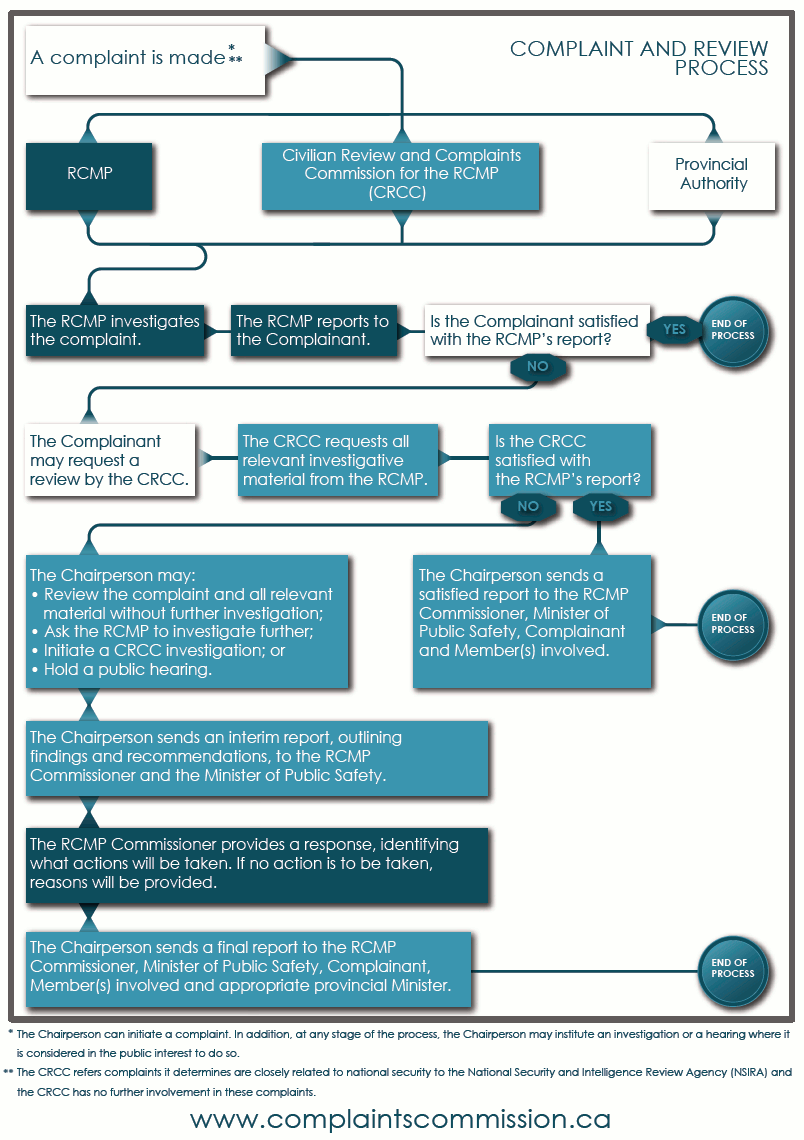
Appendix C: Complaints by Member Rank
| Member Rank | n Force-wide Total |
% Force-wide Total |
|---|---|---|
| Unknown | 139 | 5% |
| Public Servant | 6 | 0% |
| Civilian Member | 1 | 0% |
| Special Constable | 3 | 0% |
| Auxiliary Constable | 10 | 0% |
| Constable | 1,864 | 72% |
| Corporal | 302 | 12% |
| Sergeant | 170 | 7% |
| Staff Sergeant | 64 | 2% |
| Inspector | 19 | 1% |
| Superintendent | 12 | 0% |
| Chief Superintendent | 2 | 0% |
| Assistant Commissioner | 4 | 0% |
| Deputy Commissioner | 1 | 0% |
| Commissioner | 2 | 0% |
| Other | 4 | 0% |
Appendix D: 16 Complaint Allegation Categories
Improper Attitude: The complaint category includes behaviour that could be seen as abusive, rude, discourteous, disrespectful, aggressive, intimidating, etc. The behaviour could also be seen to be unfair or lacking empathy.
- Improper Use of Force: The category includes allegations of inappropriate or excessive force. Improper use of force may be considered inconsistent with circumstances applied to frequently or harshly.
- Improper Use of Firearms: This category involves the use, display or discharge of a firearm.
- Irregularity in Procedure: This complaint category involves some aspect of the Privacy or Access issues, allegations that members improperly obtained information from a police data bank, and other alleged violations of an "administratively enforced" statute.
- Driving Irregularity: This complaint category includes allegations of improper or unsafe police transport, pursuits or operation of emergency vehicles.
- Neglect of Duty: This is a broad category that encompasses alleged behaviour that a member failed to or refused to perform a duty or provide an expected service. Such allegations could include failure to identify oneself, mismanagement of public complaints, inadequate investigations, improper care of prisoners, failure to release detained persons into a safe environment, and failure to provide appropriate medical care. This category could also include allegations of deficient reporting related to note books, investigations, occurrence reports.
- Statutory Offence: This complaint category is reserved for allegations that members violated sections of the Criminal Code of Canada, federal, provincial or municipal statutes.
- Mishandling of Property: This complaint category includes allegations about the loss of property, damage to property and the unreasonable detention of property.
- Irregularity–Evidence: These allegations would include concerns around members testifying in judicial proceedings, failure or refusal to report the facts of a public complaint, and failure or refusal to testify to correct or true facts.
- Oppressive Conduct: The complaint category would include these allegations that would surpass what would be considered improper attitude, irregular procedure and neglect of duty.
- Improper Arrest: This category involves allegations of failing to inform an individual for the reason for their arrest, right to counsel or failing to provide an opportunity to exercise these rights.
- Improper Persons/Vehicles Search: These allegations would include complaints of personal and vehicle searches as well as potential violations of section 8 of the Charter of Rights and Freedoms.
- Improper Search of Premises: The complaint category includes allegations concerning members who have entered or remain unlawfully in a premise.
- Policy: These allegations are specifically about RCMP policy and their application.
- Equipment: This category applies to allegations of improper use of RCMP equipment.
- Service: This complaint category includes allegations that members did not respond or failed to provide timely service.
Appendix E: Force-Wide Issues Breakdown
| Issues | Number of Issues | % |
|---|---|---|
| Aboriginal Community | 61 | 1% |
| Abusive Language | 101 | 2% |
| Alcohol/Drugs (not intoxication) | 130 | 2% |
| Arrest | 481 | 8% |
| Attitude | 866 | 15% |
| Care In Custody | 46 | 1% |
| Chemical Irritants | 35 | 1% |
| Child Abuse Response | 39 | 1% |
| Child Custody | 36 | 1% |
| Civil Disputes/No Child | 84 | 1% |
| Conflict of Interest | 59 | 1% |
| Criminal Investigation Quality | 524 | 9% |
| Crowd Control | 3 | 0% |
| Custody Deaths | 2 | 0% |
| Detention | 179 | 3% |
| Entry of Premises | 106 | 2% |
| Informants/Sources | 26 | 0% |
| Intoxication | 240 | 4% |
| Lethal Weapons | 45 | 1% |
| Lying Under Oath | 8 | 0% |
| Medical Care | 68 | 1% |
| Mental Illness | 90 | 2% |
| National Security | 3 | 0% |
| Non-Custody Deaths | 17 | 0% |
| Non-Lethal Weapons/No Chem. | 36 | 1% |
| Non-Pursuit Police Driving | 53 | 1% |
| Non-Spousal, Non-Child Assault Response | 132 | 2% |
| Non-Spousal, Non-Child Sexual Assault Response | 6 | 0% |
| Note-Taking Quality | 10 | 0% |
| Use of Police Dogs | 16 | 0% |
| Police Physical Abuse No Restraints | 290 | 5% |
| Police Pursuit Driving | 13 | 0% |
| Policy | 11 | 0% |
| Property Mishandling | 109 | 2% |
| Public Complaint Investigation Quality | 17 | 0% |
| Release/Disclosure of Information | 105 | 2% |
| Restraints | 63 | 1% |
| Right to Counsel | 56 | 1% |
| Search | 214 | 4% |
| Seizure | 122 | 2% |
| Service | 421 | 7% |
| Spousal Abuse Response | 66 | 1% |
| Vehicular Incidents | 469 | 8% |
| Witness Protection Program | 3 | 0% |
| Youth Interaction | 71 | 1% |
| Youth Involvement | 176 | 3% |
| Total | 5708 |
Appendix F: Force-Wide Allegations Breakdown
| Allegation | n Force-wide Total |
% Force-wide Total |
|---|---|---|
| A. Improper Attitude | 924 | 19% |
| B. Improper Use of Force | 569 | 12% |
| C. Improper Use of Firearms | 44 | 1% |
| D. Irregularity in Procedure | 371 | 8% |
| E. Driving Irregularity | 71 | 1% |
| F. Neglect of Duty | 1,567 | 32% |
| G. Statutory Offence | 119 | 2% |
| H. Mishandling of Property | 115 | 2% |
| I. Irregularity – Evidence | 25 | 1% |
| J. Oppressive Conduct | 331 | 7% |
| K. Improper Arrest | 336 | 7% |
| L. Improper Persons/Vehicles Search | 98 | 2% |
| M. Improper Search of Premises | 168 | 3% |
| N. Policy | 26 | 1% |
| O. Equipment | 5 | 0% |
| P. Service | 63 | 1% |
| Q. Other | 3 | 0% |
| Total | 4,835 |
Appendix G: Allegations Breakdown by region
| Allegation | n Pacific |
% Pacific |
n Northwest |
% Northwest |
n Atlantic |
% Atlantic |
n Central |
% Central |
n Total |
% Total |
|---|---|---|---|---|---|---|---|---|---|---|
| A. Improper Attitude | 334 | 17% | 403 | 19% | 160 | 26% | 27 | 16% | 924 | 19% |
| B. Improper Use of Force | 309 | 16% | 187 | 9% | 70 | 11% | 3 | 2% | 569 | 12% |
| C. Improper Use of Firearms | 21 | 1% | 14 | 1% | 8 | 1% | 1 | 1% | 44 | 1% |
| D. Irregularity in Procedure | 129 | 7% | 191 | 9% | 39 | 6% | 12 | 7% | 371 | 8% |
| E. Driving Irregularity | 19 | 1% | 38 | 2% | 9 | 1% | 5 | 3% | 71 | 1% |
| F. Neglect of Duty | 561 | 29% | 748 | 35% | 177 | 29% | 81 | 48% | 1,567 | 32% |
| G. Statutory Offence | 25 | 1% | 89 | 4% | 4 | 1% | 1 | 1% | 119 | 2% |
| H. Mishandling of Property | 52 | 3% | 44 | 2% | 15 | 2% | 4 | 2% | 115 | 2% |
| I. Irregularity – Evidence | 6 | 0% | 16 | 1% | 3 | 0% | 0 | 0% | 25 | 1% |
| J. Oppressive Conduct | 162 | 8% | 99 | 5% | 41 | 7% | 29 | 17% | 331 | 7% |
| K. Improper Arrest | 185 | 10% | 126 | 6% | 23 | 4% | 2 | 1% | 336 | 7% |
| L. Improper Persons/Vehicles Search | 25 | 1% | 52 | 2% | 21 | 3% | 0 | 0% | 98 | 2% |
| M. Improper Search of Premises | 66 | 3% | 78 | 4% | 22 | 4% | 2 | 1% | 168 | 3% |
| N. Policy | 10 | 1% | 10 | 0% | 5 | 1% | 1 | 1% | 26 | 1% |
| O. Equipment | 4 | 0% | 1 | 0% | 0 | 0% | 0 | 0% | 5 | 0% |
| P. Service | 13 | 1% | 38 | 2% | 11 | 2% | 1 | 1% | 63 | 1% |
| Q. Other | 0 | 0% | 2 | 0% | 1 | 0% | 0 | 0% | 3 | 0% |
| Total | 1,921 | 2,136 | 609 | 169 | 4,835 |
Appendix H: Allegations Breakdown Based on the Organization the Complaints Were Lodged With
| Allegations | n CPC |
% CPC |
n RCMP |
% RCMP |
n FSIN |
% FSIN |
n Alberta Solicitor General |
% Alberta Solicitor General |
n CHRC |
% CHRC |
n Total |
|---|---|---|---|---|---|---|---|---|---|---|---|
| A. Improper Attitude | 608 | 66% | 308 | 33% | 3 | 0% | 5 | 1% | 0 | 0% | 924 |
| B. Improper Use of Force | 388 | 68% | 178 | 31% | 2 | 0% | 1 | 0% | 0 | 0% | 569 |
| C. Improper Use of Firearms | 39 | 89% | 5 | 11% | 0 | 0% | 0 | 0% | 0 | 0% | 44 |
| D. Irregularity in Procedure | 282 | 76% | 83 | 22% | 1 | 0% | 3 | 1% | 2 | 1% | 371 |
| E. Driving Irregularity | 48 | 68% | 21 | 30% | 2 | 3% | 0 | 0% | 0 | 0% | 71 |
| F. Neglect of Duty | 1,301 | 83% | 253 | 16% | 2 | 0% | 11 | 1% | 0 | 0% | 1,567 |
| G. Statutory Offence | 64 | 54% | 54 | 45% | 0 | 0% | 1 | 1% | 0 | 0% | 119 |
| H. Mishandling of Property | 88 | 77% | 27 | 23% | 0 | 0% | 0 | 0% | 0 | 0% | 115 |
| I. Irregularity – Evidence | 18 | 72% | 7 | 28% | 0 | 0% | 0 | 0% | 0 | 0% | 25 |
| J. Oppressive Conduct | 210 | 63% | 120 | 36% | 0 | 0% | 1 | 0% | 0 | 0% | 331 |
| K. Improper Arrest | 264 | 79% | 72 | 21% | 0 | 0% | 0 | 0% | 0 | 0% | 336 |
| L. Improper Persons/Vehicles Search | 80 | 82% | 18 | 18% | 0 | 0% | 0 | 0% | 0 | 0% | 98 |
| M. Improper Search of Premises | 133 | 79% | 31 | 18% | 0 | 0% | 4 | 2% | 0 | 0% | 168 |
| N. Policy | 14 | 54% | 12 | 46% | 0 | 0% | 0 | 0% | 0 | 0% | 26 |
| O. Equipment | 5 | 100% | 0 | 0% | 0 | 0% | 0 | 0% | 0 | 0% | 5 |
| P. Service | 58 | 92% | 4 | 6% | 0 | 0% | 1 | 2% | 0 | 0% | 63 |
| Q. Other | 1 | 33% | 2 | 67% | 0 | 0% | 0 | 0% | 0 | 0% | 3 |
| Total | 3,601 | 1,195 | 10 | 27 | 2 | 4,835 | |||||
| Percentage of Total | 74.5% | 24.7% | 0.2% | 0.6% | 0% |
Appendix I: Allegations Breakdown for Final ReportsFootnote 43
| Allegation | n Pacific |
% Pacific |
n Northwest |
% Northwest |
n Atlantic |
% Atlantic |
n Central |
% Central |
n Total |
% Total |
|---|---|---|---|---|---|---|---|---|---|---|
| A. Improper Attitude | 157 | 13% | 195 | 15% | 14 | 14% | 110 | 25% | 476 | 16% |
| B. Improper Use of Force | 239 | 20% | 149 | 11% | 3 | 3% | 59 | 13% | 450 | 15% |
| C. Improper Use of Firearms | 16 | 1% | 9 | 1% | 1 | 1% | 6 | 1% | 32 | 1% |
| D. Irregularity in Procedure | 73 | 6% | 118 | 9% | 4 | 4% | 24 | 5% | 219 | 7% |
| E. Driving Irregularity | 12 | 1% | 13 | 1% | 5 | 5% | 5 | 1% | 35 | 1% |
| F. Neglect of Duty | 332 | 28% | 466 | 35% | 52 | 53% | 143 | 32% | 993 | 33% |
| G. Statutory Offence | 16 | 1% | 83 | 6% | 1 | 1% | 2 | 0% | 102 | 3% |
| H. Mishandling of Property | 41 | 4% | 29 | 2% | 2 | 2% | 12 | 3% | 84 | 3% |
| I. Irregularity – Evidence | 1 | 0% | 14 | 1% | 0 | 0% | 2 | 0% | 17 | 1% |
| J. Oppressive Conduct | 90 | 8% | 75 | 6% | 13 | 13% | 22 | 5% | 200 | 7% |
| K. Improper Arrest | 118 | 10% | 87 | 7% | 0 | 0% | 19 | 4% | 224 | 7% |
| L. Improper Persons/Vehicles Search | 16 | 1% | 32 | 2% | 0 | 0% | 10 | 2% | 58 | 2% |
| M. Improper Search of Premises | 43 | 4% | 40 | 3% | 1 | 1% | 16 | 4% | 100 | 3% |
| N. Policy | 6 | 1% | 3 | 0% | 1 | 1% | 5 | 1% | 15 | 0% |
| O. Equipment | 3 | 0% | 1 | 0% | 0 | 0% | 0 | 0% | 4 | 0% |
| P. Service | 3 | 0% | 11 | 1% | 1 | 1% | 7 | 2% | 22 | 1% |
| Q. Other | 0 | 0% | 0 | 0% | 0 | 0% | 1 | 0% | 1 | 0% |
| Total | 1,166 | 1,325 | 98 | 443 | 3,032 |
Appendix J: Supported and Unsupported Allegations
| Allegations | n Supported |
% Supported |
n Unsupported |
% Unsupported |
n Total |
|---|---|---|---|---|---|
| A. Improper Attitude | 74 | 16% | 393 | 84% | 467 |
| B. Improper Use of Force | 13 | 3% | 432 | 97% | 445 |
| C. Improper Use of Firearms | 1 | 3% | 30 | 97% | 31 |
| D. Irregularity in Procedure | 23 | 11% | 190 | 89% | 213 |
| E. Driving Irregularity | 5 | 14% | 30 | 86% | 35 |
| F. Neglect of Duty | 97 | 10% | 872 | 90% | 969 |
| G. Statutory Offence | 0 | 0% | 102 | 100% | 102 |
| H. Mishandling of Property | 14 | 18% | 64 | 82% | 78 |
| I. Irregularity – Evidence | 0 | 0% | 15 | 100% | 15 |
| J. Oppressive Conduct | 11 | 6% | 188 | 94% | 199 |
| K. Improper Arrest | 13 | 6% | 207 | 94% | 220 |
| L. Improper Persons/Vehicles Search | 3 | 6% | 47 | 94% | 50 |
| M. Improper Search of Premises | 8 | 9% | 86 | 91% | 94 |
| N. Policy | 8 | 53% | 7 | 47% | 15 |
| O. Equipment | 0 | 0% | 4 | 100% | 4 |
| P. Service | 7 | 32% | 15 | 68% | 22 |
| Q. Other | 0 | 0% | 1 | 100% | 1 |
| Total | 277 | 2,683 | 2,960 |
Appendix K: Allegations Breakdown for Informal ResolutionsFootnote 44
| Allegation | n Pacific |
% Pacific |
n Northwest |
% Northwest |
n Atlantic |
% Atlantic |
n Central |
% Central |
n Total |
% Total |
|---|---|---|---|---|---|---|---|---|---|---|
| A. Improper Attitude | 122 | 27% | 146 | 32% | 4 | 20% | 34 | 34% | 306 | 30% |
| B. Improper Use of Force | 39 | 9% | 15 | 3% | 0 | 0% | 4 | 4% | 58 | 6% |
| C. Improper Use of Firearms | 1 | 0% | 2 | 0% | 0 | 0% | 0 | 0% | 3 | 0% |
| D. Irregularity in Procedure | 30 | 7% | 39 | 8% | 0 | 0% | 9 | 9% | 78 | 8% |
| E. Driving Irregularity | 4 | 1% | 21 | 5% | 0 | 0% | 3 | 3% | 28 | 3% |
| F. Neglect of Duty | 134 | 30% | 148 | 32% | 7 | 35% | 20 | 20% | 309 | 30% |
| G. Statutory Offence | 1 | 0% | 3 | 1% | 0 | 0% | 0 | 0% | 4 | 0% |
| H. Mishandling of Property | 5 | 1% | 10 | 2% | 1 | 5% | 0 | 0% | 16 | 2% |
| I. Irregularity – Evidence | 0 | 0% | 1 | 0% | 0 | 0% | 1 | 1% | 2 | 0% |
| J. Oppressive Conduct | 48 | 11% | 5 | 1% | 8 | 40% | 12 | 12% | 73 | 7% |
| K. Improper Arrest | 41 | 9% | 27 | 6% | 0 | 0% | 2 | 2% | 70 | 7% |
| L. Improper Persons/Vehicles Search | 7 | 2% | 6 | 1% | 0 | 0% | 7 | 7% | 20 | 2% |
| M. Improper Search of Premises | 8 | 2% | 13 | 3% | 0 | 0% | 6 | 6% | 27 | 3% |
| N. Policy | 3 | 1% | 6 | 1% | 0 | 0% | 0 | 0% | 9 | 1% |
| O. Equipment | 0 | 0% | 0 | 0% | 0 | 0% | 0 | 0% | 0 | 0% |
| P. Service | 5 | 1% | 21 | 5% | 0 | 0% | 2 | 2% | 28 | 3% |
| Q. Other | 0 | 0% | 0 | 0% | 0 | 0% | 0 | 0% | 0 | 0% |
| Total | 448 | 463 | 20 | 100 | 1,031 |
Appendix L: Allegations Breakdown for Withdrawn ComplaintsFootnote 45
| Allegation | n Pacific |
% Pacific |
n Northwest |
% Northwest |
n Atlantic |
% Atlantic |
n Central |
% Central |
n Total |
% Total |
|---|---|---|---|---|---|---|---|---|---|---|
| A. Improper Attitude | 38 | 19% | 54 | 17% | 6 | 30% | 14 | 24% | 112 | 19% |
| B. Improper Use of Force | 29 | 14% | 22 | 7% | 0 | 0% | 7 | 12% | 58 | 10% |
| C. Improper Use of Firearms | 1 | 0% | 3 | 1% | 0 | 0% | 1 | 2% | 5 | 1% |
| D. Irregularity in Procedure | 14 | 7% | 32 | 10% | 4 | 20% | 5 | 9% | 55 | 9% |
| E. Driving Irregularity | 2 | 1% | 2 | 1% | 0 | 0% | 1 | 2% | 5 | 1% |
| F. Neglect of Duty | 63 | 31% | 124 | 39% | 6 | 30% | 13 | 22% | 206 | 34% |
| G. Statutory Offence | 3 | 1% | 3 | 1% | 0 | 0% | 0 | 0% | 6 | 1% |
| H. Mishandling of Property | 5 | 2% | 5 | 2% | 1 | 5% | 3 | 5% | 14 | 2% |
| I. Irregularity – Evidence | 1 | 0% | 1 | 0% | 0 | 0% | 0 | 0% | 2 | 0% |
| J. Oppressive Conduct | 9 | 4% | 18 | 6% | 2 | 10% | 6 | 10% | 35 | 6% |
| K. Improper Arrest | 18 | 9% | 11 | 3% | 1 | 5% | 2 | 3% | 32 | 5% |
| L. Improper Persons/Vehicles Search | 2 | 1% | 13 | 4% | 0 | 0% | 4 | 7% | 19 | 3% |
| M. Improper Search of Premises | 11 | 5% | 25 | 8% | 0 | 0% | 0 | 0% | 36 | 6% |
| N. Policy | 1 | 0% | 1 | 0% | 0 | 0% | 0 | 0% | 2 | 0% |
| O. Equipment | 1 | 0% | 0 | 0% | 0 | 0% | 0 | 0% | 1 | 0% |
| P. Service | 4 | 2% | 3 | 1% | 0 | 0% | 2 | 3% | 9 | 2% |
| Q. Other | 0 | 0% | 2 | 1% | 0 | 0% | 0 | 0% | 2 | 0% |
| Total | 202 | 319 | 20 | 58 | 599 |
Appendix M: Allegations Breakdown for Terminated ComplaintsFootnote 46
| Allegation | n Pacific |
% Pacific |
n Northwest |
% Northwest |
n Atlantic |
% Atlantic |
n Central |
% Central |
n Total |
% Total |
|---|---|---|---|---|---|---|---|---|---|---|
| A. Improper Attitude | 17 | 16% | 8 | 28% | 3 | 10% | 2 | 25% | 30 | 17% |
| B. Improper Use of Force | 2 | 2% | 1 | 3% | 0 | 0% | 0 | 0% | 3 | 2% |
| C. Improper Use of Firearms | 3 | 3% | 0 | 0% | 0 | 0% | 1 | 13% | 4 | 2% |
| D. Irregularity in Procedure | 12 | 11% | 2 | 7% | 4 | 13% | 1 | 13% | 19 | 11% |
| E. Driving Irregularity | 1 | 1% | 2 | 7% | 0 | 0% | 0 | 0% | 3 | 2% |
| F. Neglect of Duty | 32 | 30% | 10 | 34% | 16 | 52% | 1 | 13% | 59 | 34% |
| G. Statutory Offence | 5 | 5% | 0 | 0% | 0 | 0% | 2 | 25% | 7 | 4% |
| H. Mishandling of Property | 1 | 1% | 0 | 0% | 0 | 0% | 0 | 0% | 1 | 1% |
| I. Irregularity – Evidence | 4 | 4% | 0 | 0% | 0 | 0% | 0 | 0% | 4 | 2% |
| J. Oppressive Conduct | 15 | 14% | 1 | 3% | 6 | 19% | 1 | 13% | 23 | 13% |
| K. Improper Arrest | 8 | 8% | 1 | 3% | 1 | 3% | 0 | 0% | 10 | 6% |
| L. Improper Persons/Vehicles Search | 0 | 0% | 1 | 3% | 0 | 0% | 0 | 0% | 1 | 1% |
| M. Improper Search of Premises | 4 | 4% | 0 | 0% | 1 | 3% | 0 | 0% | 5 | 3% |
| N. Policy | 0 | 0% | 0 | 0% | 0 | 0% | 0 | 0% | 0 | 0% |
| O. Equipment | 0 | 0% | 0 | 0% | 0 | 0% | 0 | 0% | 0 | 0% |
| P. Service | 1 | 1% | 3 | 10% | 0 | 0% | 0 | 0% | 4 | 2% |
| Q. Other | 0 | 0% | 0 | 0% | 0 | 0% | 0 | 0% | 0 | 0% |
| Total | 105 | 29 | 31 | 8 | 173 |
- Date modified:



